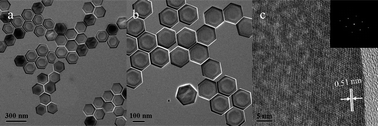Monodisperse, hexagonal phase NaLuF4 : Yb,Tm nanoplates (NPs) with uniform size have been successfully synthesized by a novel solution-based method. The nanoplates have a perfect hexagonal shape with a diameter of ∼180 nm. As a chelating agent and shape modifier, oleic acid (OA) was introduced into the reaction mixture and played a key role in fine-tuning the nanoplates. A possible growth mechanism was proposed for the formation of β-NaLuF4 nanoplates. Spectral analysis showed that the β-NaLuF4 : Yb,Tm nanoplates were excellent materials for intense ultraviolet and blue upconversion luminescence. To our best knowledge, it is the first time such intense 5-photon upconversion fluorescence from the 1I6 level of Tm3+ ions, which is much stronger than the 4-photon upconversion fluorescence from the 1D2 level and the 3-photon upconversion fluorescence from the 1G4 level, has been demonstrated. The analysis on temporal evolutions of UC luminescence suggests that β-NaLuF4 nanocrystals might be a better kind of upconversion material than their β-NaYF4 counterpart. This powerfully demonstrates that β-NaLuF4 is an excellent host lattice for upconversion luminescence materials. Due to the unique luminescence, these β-NaLuF4 nanoplates may be promising for further fundamental research and applications in color displays and solid-state lasers.

You have access to this article
 Please wait while we load your content...
Something went wrong. Try again?
Please wait while we load your content...
Something went wrong. Try again?


 Please wait while we load your content...
Please wait while we load your content...